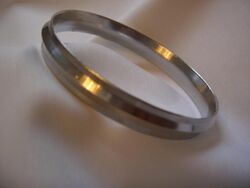Kara (Sikhism)
Topic: Religion
 From HandWiki - Reading time: 5 min
From HandWiki - Reading time: 5 min
| Part of a series on |
| Sikhism |
|---|
 |
A kara (Punjabi: ਕੜਾ (Gurmukhi), کڑا (Shahmukhi) कड़ा (Devanagari)) is a steel or cast iron (sarb loh) bangle worn by Sikhs. It is not necessary expected to be worn by all Sikhs however it’s preferred and shows your devotion to Sikhism.The religion rather preaches the message of treating everyone equally, and having a remembrance of god at all times. It is one of the five Dakar's or five Ks—external articles of faith—that identify a Sikh as dedicated to the religious order of Sikhism.
History
The kara was instituted by the tenth Sikh guru Gobind Singh at the Baisakhi Amrit Sanchar in 1699. Guru Gobind Singh explained:
He does not recognize anyone else except me, not even the bestowal of charities, the performance of merciful acts, austerities, and restraint on pilgrim-stations; the perfect light of the Lord illuminates his heart, then consider him as the immaculate Khalsa.—Guru Gobind Singh[2]
Meaning and usage
Theology
The Kara is a symbol of unbreakable attachment and commitment to God.[3] As the Sikhs' holy text the Guru Granth Sahib says "In the tenth month, you were made into a human being, O my merchant friend, and you were given your allotted time to perform good deeds."[4] Similarly, Bhagat Kabir reminds the Sikh to always keep one's consciousness with God: "With your hands and feet, do all your work, but let your consciousness remain with the Immaculate Lord."[5] The kara is also worn by many Sikhs and other non-Sikh Indian families across the states in the North, North-West and West of India (such as Gujarat, Rajasthan, and even Maharashtra) by Hindus;[6] moreover, the use of the kara by non-Sikhs is encouraged as it represents the "totality of God".[7]
The basic kara is a simple unadorned iron bracelet, but other forms exist. The Kara is one of the most basic symbols of the Sikh faith. All Sikhs are expected to wear the Kara as all are expected to not cut their hair (a second very critical element of the identity of the Sikh). Both of these fall in the realm of the 5 articles worn by Sikhs as a part of their uniform.
Combat
It was also historically used like a knuckle-duster for hand-to-hand combat. Battlefield variations include kara with spikes or sharp edges. Sikh soldiers serving for the British army in India would settle disputes by competing in a form of boxing known as loh-muthi (lit. iron fist) with a kara on one hand. [8]
See also
- Kara (jewellery)
References
- ↑ Hardip Singh Syan (2013). Sikh Militancy in the Seventeenth Century: Religious Violence in Mughal and Early Modern India. I.B.Tauris. pp. 52–54. ISBN 978-1-78076-250-0. https://books.google.com/books?id=9RzzxcEL4C0C&pg=PA52.
- ↑ in the Dasam Granth, page 1350
- ↑ http://www.sikhnet.com/oldsikhnet/SikhEducation/5K's.pdf [bare URL PDF]
- ↑ Guru Granth Sahib, page 76
- ↑ ||213|| - Siri Guru Granth Sahib Ji, page 1376
- ↑ Dhooleka Sarhadi Raj (25 August 2003). Where are you from?: middle-class migrants in the modern world. University of California Press. ISBN 9780520928671. https://books.google.com/books?id=HXsAbWxzZSIC&dq=Kara+Punjabi+Symbol&pg=PA63. Retrieved 17 December 2011. "Individual Sikhs and Hindus share symbols and practices of body inscription (such as wearing a kara and women keeping their hair long)."
- ↑ "FAQ". Sikh Karas. https://www.sikhkaras.com/faqs/. Retrieved 17 December 2011. "Is it okay for Non-Sikhs to wear a Sikh Kara? Yes, definitely it is. The Kara is a universal symbol of the totality of God; free for everybody to use. Any Sikh who will see the Sikh Kara on you will be happy and proud that you choose to wear it."
- ↑ Sanatan Shastarvidiya (2011-10-03), Sanatan Shastar Vidiya - LohMushti [Iron Fist Figh, https://www.youtube.com/watch?v=qUeB-RlRX9o, retrieved 2018-04-06
 |
 KSF
KSF

